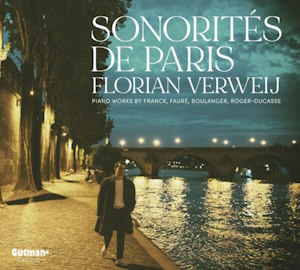
Sonorités de Paris
Florian Verweij (piano)
rec. 2024, Hilversum, Muziekcentrum van de Omroep, The Netherlands
Gutman Records CD241 [80]
Florian Verweij’s debut disc encourages the listener to savour the sounds of Paris (savourez les sonorités de Paris). The pianist notes that it was César Franck’s Prelude, aria et final that inspired him to immerse himself in French piano music for his first album. After considering what composers to include, he discovered Jean Roger-Ducasse’s Sonorités. Verweij examined the catalogue, realised that Roger-Ducasse has been largely forgotten, and decided to remedy this. The recital also includes works by his teacher Gabriel Fauré and his friend Lili Boulanger, and Franck’s piece.
Jean Jules Aimable Roger-Ducasse enjoyed a long and illustrious career. Born in Bordeaux on 18 April 1873, he trained at the Paris Conservatoire under the guidance of the now relatively unknown Émile Pessard and André Gédalge, before furthering his studies with Gabriel Fauré. In 1902, he secured second place for his cantata Alcyone in the Grand Prix de Rome. Much of his career was dedicated to teaching. In 1909, he became the Inspector of Singing in Parisian schools in 1909. In 1935, he took over from Paul Dukas as Professor of Composition at the Paris Conservatoire. Among his noteworthy pupils were Frenchmen Jacques Ibert and Jéhan Alain, and the overlooked Scottish composer Francis George Scott. Jean Roger-Ducasse passed away in Le-Taillan-Médoc near Bordeaux on 19 July 1954.
For most French music aficionados, Roger-Ducasse is recalled for a single composition: the remarkable Pastorale for organ completed in 1909. Marco Polo released two discs of his orchestral music; Nimbus and Grand Piano issued his piano works. Yet he never gained the traction that contemporary critics predicted.
The recital opens with the Barcarolle No.1, one of Roger-Ducasse’s earliest piano pieces. It does not take much appreciation of French music to detect the influence of Claude Debussy and Fauré. It was originally devised for the harp, to display Erard’s new concert instrument. It is a delicious number from the first note to the last.
In Six Preludes – unlike Debussy – he does not give any programmatic information, but relies on the opening performance indicator. So, the first cool prelude, Très nonchalant, is followed by the crystalline Très calme. D’un rythme très précis features an insistent semiquaver figure balanced by a calmer middle section. Then there is the highly chromatic Très libre. The fifth Prelude, D’un rythme capricieux et tendre, is mercurial in its metrical flexibility and change of tempo. The final Prelude signed Très souple is played with a magical affability.
Prelude d’un ballet is a miniature, just over three minutes. The opening gesture of rising parallel fifth chords is reminiscent of Debussy’s La cathédrale engloutie. Michel-Dimitri Calvocoressi described the ‘plot’ behind the ballet: “The Park, a castle once inhabited by the lords and the ladies of yesteryear, abandoned […] Autumn […] The Poet, dreaming of the past, advances”. Here we get a piano transcription of the orchestral original.
The liner notes suggest that Ravel is the model for the spirited Rythmes with its dancelike figures, polyrhythms and shifting tonality. A looking at the score shows that it is clearly fiendishly difficult to play. Ravel’s Jeux d’eau is suggested, and a definite Spanish mood.
Once more, the mantle of Debussy hangs over Sonorités. The piano presents a hazy evocation, “shimmering cascades” and elaborated melodies. This magical piece out-Debussys Debussy.
The Chante de l’aube begins with a luminous rhythmic phrase, then settles down into an enigmatic, lugubrious middle section, before the sunlight breaks through once again.
Gabriel Fauré’s Trois Romances sans paroles were his first solo works for the piano. He was only eighteen when he wrote them, but they were not published until 1879. Often criticised for being derivative of Mendelssohn and Schumann, they still charm with their emphasis on pure melody. The second Romance is virtuosic, with rapid, tumbling semiquavers in the accompaniment.
Lili Boulanger’s Thème et variations is a dark, austere work that never shows warmth or positivity, only an ominous, anguished atmosphere: this was completed when the First World War began. The piece was lost, and rediscovered in 1960.
The most substantial composition on this disc is César Franck’sPrélude, aria et final. As a large-scale piece of music, it has not been as successful as the Prélude, choral et fugue written two years earlier. One reviewer at the premiere considered that it was “long and tedious”. Another felt that “one should respect rather than listen to this French Bach and competent professor” (liner notes, Éditions de L’Oiseau-Lyre, DSLO 8). This was Franck’s last major essay for piano solo. Maurice Hinson has described it as a “sonata in one movement that uses cyclic form and is predominantly chordal”. The heart of the work is the serene Aria. This recording is robust; Verweij gives structural cohesion and integrity to a piece which that even Alfred Cortot had reservations about. And the octave passages are splendid.
Dutch pianist Florian Verweij has performed internationally – in Spain, Greece, Canada and the USA. He has won many awards, including first prize at the International Magnus Piano Competition in 2021, and was a finalist at the Ettlingen International Competition for Young Pianists in 2018. He made his début at the splendid Concertgebouwin Amsterdam in 2023, and released this début album in November 2024.
The liner notes by Florian Verweij and Loni Verweij, in Dutch and English, helpfully set this remarkable recital in context, and give useful information about all the music.
The performance of all this music distinctly demonstrates Florian Verweij’s virtuosic technique, as well as his understanding of the more intimate moments in this repertoire.
John France
Availability: Gutman RecordsContents
Jean Roger-Ducasse (1873-1954)
Barcarolle No.1 (1907)
Chante de l’aube (1921)
Sonorités (1919)
Rythmes (1917)
Gabriel Fauré (1845-1924)
Trois romances sans paroles, op.17 (1863)
Lili Boulanger (1893-1918)
Thème et variations (1911-1914)Jean Roger-Ducasse
Prelude d’un ballet (1910)
Six Preludes (1907)
César Franck (1822-1890)
Prélude, aria et final, FWV23 (1886-1887)


















